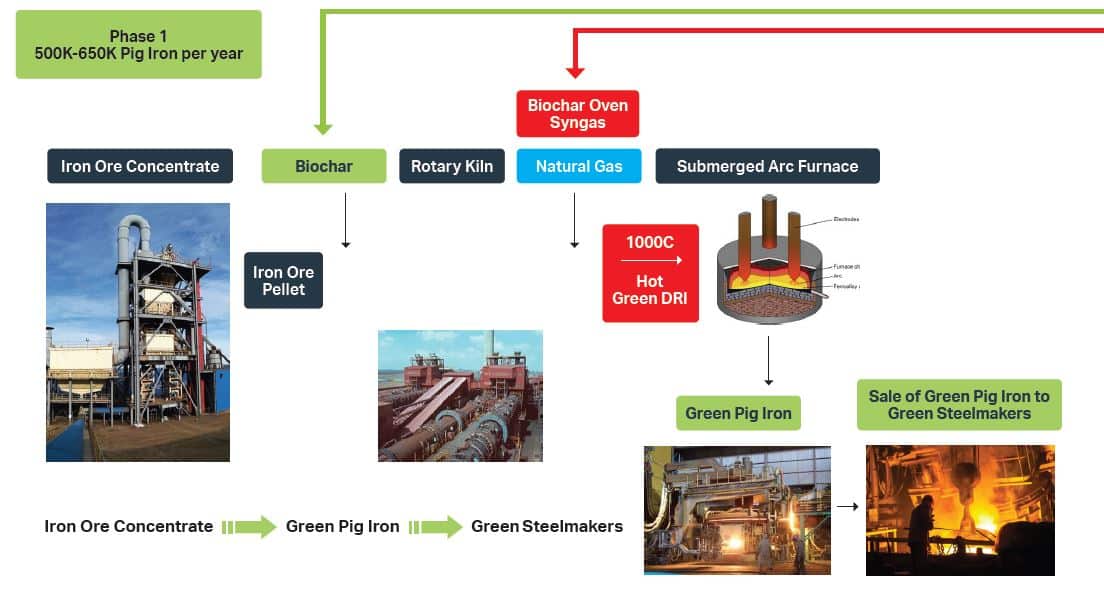As the global steel industry strives to achieve net zero, it had many challenges ahead as the industry is the largest emitting manufacturing sector.
Steel generates ~7% of all man-made emissions and 70% of steel production is fueled by coal. “Green Pig Iron” might be one of the ways to lead the industry down the decarbonization path.
But going net zero won’t be cheap. It is estimated that it can cost the steel industry anywhere from $215 to $278 billion. But using green solutions, like biomass, might lower the price in the long term.
- Right now, steel costs $726 per metric ton but under green technology, it may go down to below $500.
The steel industry is currently very reliant on coal and green pig iron can offer a solution for the industry to decarbonize.
The Traditional Steelmaking Process
A critical input for construction and engineering, steel is a very important material with over 2 billion tons produced yearly. But this comes at a hefty price for the environment.
Traditional steel production currently emits about 7% of the world’s greenhouse gases into the atmosphere. And 70% of steel production is fueled by coal.
Steelmaking involves several production stages.
In a traditional blast furnace-based process, iron ore is crushed and turned into sinter or pellets. In a separate location, the coal is baked and converted into coke.
Then the ore and coke are mixed with limestone and fed into a large blast furnace with extremely hot air.
Under high temperatures, the burning coke and the mixture produces liquid iron otherwise known as “pig iron”. The molten material then goes into an oxygen furnace.
There, it’ll be blasted with pure oxygen through a water-cooled lance. This process forces off carbon to leave crude steel as a final product.
This traditional steel production method produces CO2 emissions in several ways:
- carbon trapped in coke and limestone binds with oxygen in the air and creates CO2 as a byproduct;
- fossil fuels are burned to heat the blast furnace; and
- coal is also used to power sintering and pelletizing plants, as well as coke ovens, releasing CO2 in the process.
About 70% of the world’s steel is produced this way, generating nearly 2 tons of CO2 for each ton of steel produced.
The remaining 30% is made through electric arc furnaces (EAFs), which emit lower levels of CO2 than blast furnaces.
As steel production is expected to rise by a third by 2050, its environmental burden will also grow. This poses a significant challenge for tackling the climate crisis.
To meet the Paris Agreement, emissions from steel and other heavy industries need to fall by 93% by 2050. And so steelmakers face high pressure to slash their emissions.
But most companies are not looking at replacing coal in producing pig iron. Some are experimenting with the use of hydrogen or electricity.
But there’s another way that seems to show promising results for greener steelmaking.
The Green Pig Iron Production
Green pig iron is iron ore that has been processed using low emission technologies and inputs. It’s produced without using coal but through the renewable input of biomass called biochar.
- Biochar is solid material from waste materials that can store carbon for a very long time.
By replacing coal with biochar, the green pig iron process can reduce emissions by up to 100% according to Tecnored, a subsidiary of mining giant Vale.
Using biochar for green pig iron involves fewer production stages. It eliminates the need for sintering and coking. This also makes the technology 10-15% less cost-intensive than traditional blast furnace systems.
Below is a sample process flow in producing green pig iron. It’s from a Nevada-based green pig iron company Magnum.

- Iron ore concentrate is mixed with biochar and pelletized. The use of biochar significantly reduces the production footprint.
- The pellets were then fed into the rotary kiln where the temperature is very high (1000 Celsius).
- As the pellets moved along the kiln, the reduction process took place and DRI (Direct Reduced Iron) was produced.
- The DRI was melted in an electric furnace to produce high-quality pig iron
High-grade iron ore is becoming more expensive and scarcer.
Producing green pig iron using biochar can help the iron and steel industry achieve its sectoral 2°C target and hit net zero by 2050.

